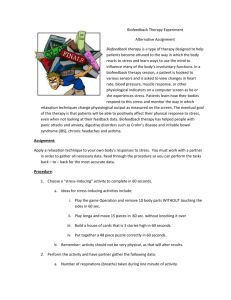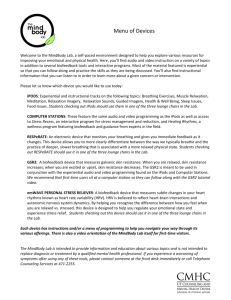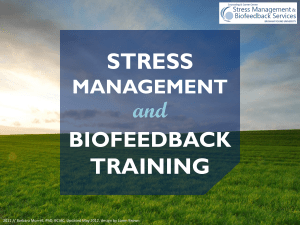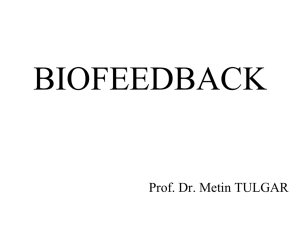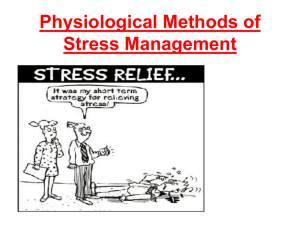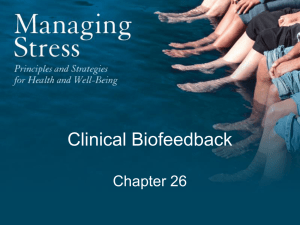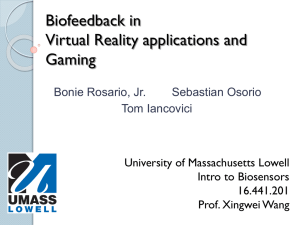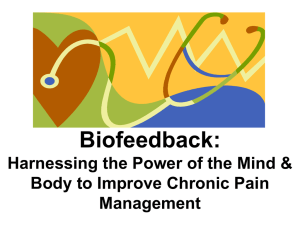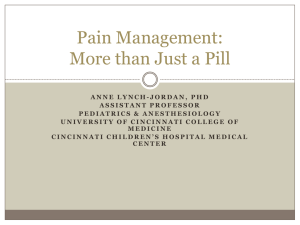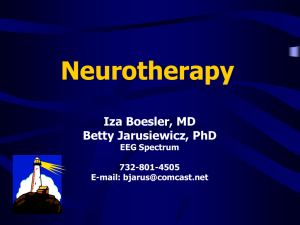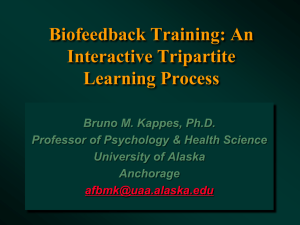FAIS-Presentation-to
advertisement
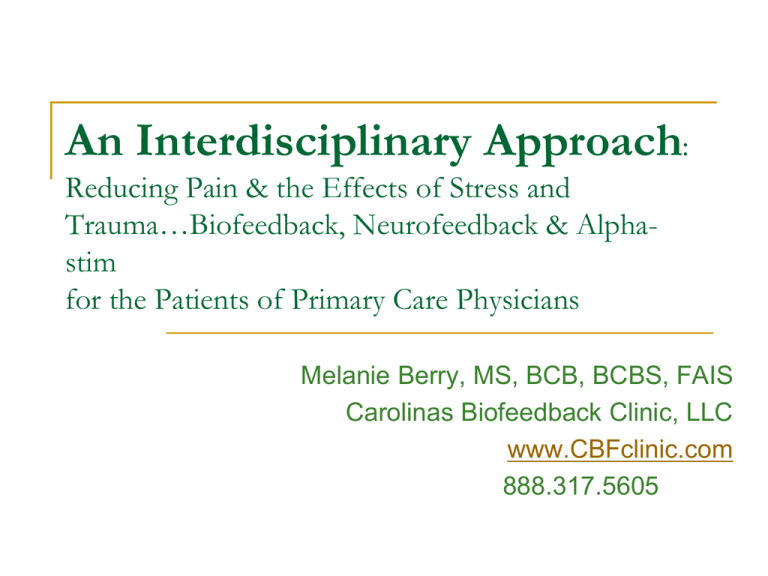
An Interdisciplinary Approach: Reducing Pain & the Effects of Stress and Trauma…Biofeedback, Neurofeedback & Alphastim for the Patients of Primary Care Physicians Melanie Berry, MS, BCB, BCBS, FAIS Carolinas Biofeedback Clinic, LLC www.CBFclinic.com 888.317.5605 Agenda: 10, 4, 30 Get to know Biofeedback for your patients with 10 Interactive Questions, covering 4 Categories, in 30 minutes Define it Teach you what conditions it is used for Help you select the right patients Help set your expectations for results Let’s begin with 3 questions… 2 Interactive Question #1 Which of these complementary or alternative medicines would you be most likely to consider for your complex pain patients? 1. Acupuncture 2. Chiropractic 3. Medical nutrition therapy 4. Biofeedback (includes neurofeedback) 5. Medications 6. Hypnosis 7. Meditation, Yoga or Tai Chi 8. Massage 9. Exercise Therapy 10. None of these 3 Interactive Question #2 Is the following statement true or false? Board Certification is available for biofeedback specialists. 1.True 2.False 4 Interactive Question #3 Which of these is NOT a type of biofeedback: 1. 2. 3. 4. 5. 6. 7. 8. 9. EMG Training EEG Training Temperature Training Hemoencyphalography (pirHEG) Training Heart Rate Variability (HRV) Training Skin Conductance Training Respiration Training None of these are types of Biofeedback All of these are types of Biofeedback 5 Theoretical Framework of Health Physiology Pathology Biochemistry Thoughts Emotions Behaviors Biological, Psychological, and Social All play a roll in human functioning, disease, illness, and chronic pain Overview of Biofeedback Modalities Modality Description Brainwave (EEG) Uses scalp sensors to monitor the brain’s electrical activity using (EEG) sensors Breathing Uses bands placed around the abdomen/chest to monitor breathing pattern and pace and calculate resonant breathing frequency. Heart Rate Variability (HRV) Uses a finger/earlobe sensor to measure heart rate and calculate heart rate variability and coherence. Muscle (EMG) Uses sensors placed over skeletal muscles to monitor the electrical activity that causes skeletal muscle contraction. Sweat Gland (GSR) Uses sensors placed around the fingers to monitor changes in skin moisture produced by sweat glands. Temperature Uses a finger sensor to measure changes in blood flow controlled by dialating and constricting blood vessels. Source: BCIA Psychosomatics and Psychopathology “Autonomic Imbalance and Decreased Parasympathetic Tone in particular may be the final common pathway linking negative affective states and dispositions, including the indirect effects via poor lifestyles, to numerous diseases and conditions as well as increased mortality, and it may also be implicated in psychopathological conditions”. Thayer & Brosschot, 2005, p. 1053 What is Biofeedback? BASIC: Biofeedback is a technique that enables an individual to learn how to change maladaptive physiological activity and correct dysfunctional Autonomic Nervous System (ANS) activity SCIENTIFIC: Biofeedback instruments are used to “feed back” information about physiological processes, assisting the individual to increase awareness of these processes and to gain voluntary control over body and mind. HOLISTIC: Biofeedback is based on the recognition that changes in the mind and emotions affect the body, and changes in the body influence the mind and emotions. RESILIENCE: Biofeedback emphasizes training individuals to selfregulate, gain awareness, increase control over their bodies, brains, and nervous systems, and improve flexibility in physiologic responding. Interactive Question #4 Is the following statement true or false? All Biofeedback techniques are non-invasive. 1. True 2. False 10 Interactive Question #5 Is the following statement true or false? Biofeedback is an evidence-based practice. 1. True 2. False 11 Interactive Question #6 Based on meta-analysis of current scientific biofeedback studies, for which of the following diagnoses is biofeedback rated as an “efficacious treatment of choice”? 1.Anxiety 2.Migraine and/or tension-type headaches 3.Chronic Pain Syndromes 4.Insomnia 5.Neuromuscular disorders 6.Irritable bowel syndrome (IBS) 7.Essential hypertension 8.None of these 9.All of these 12 Interactive Question #7 What do you do with the patient that does not get better despite all your efforts and continues to return to your practice? 1.I tell them there is nothing more I can do for them 2.I tell them to keep trying what we are already doing, give it time 3.I tell them to come back in six months, and hope things have resolved on their own 4.I tell them medicine can’t help, seek a psychologist 5.I would refer them to a complementary/alternative medicine expert 13 Who is the Ideal Patient for Biofeedback? Individuals who want a more active role in their own health care Ones looking for non-invasive treatment options Those who WANT or NEED alternatives to meds Cases involving past trauma Patients who express hopelessness or helplessness Multi-symptom, complex cases in which conventional interventions have minimal success Pain patients with secondary anxiety, depression, insomnia, PTSD, etc. NOTE: Skeptics are welcome! 14 What it Looks Like in the Individual Camp Pendelton, Neurofeedback, PTSD Veteran Benefits of Biofeedback Skilled at SelfRegulation, SelfSoothing, Relaxation Resilient to Effects of Stress Psychologic Improved Mood Stability Able to Adjust Pain Perception Interactive Question #8 Have you ever had a patient who is experiencing unrelenting pain, but for whom there is no apparent anatomical origin (i.e., via X-ray, MRI, CT scan, etc.)? 1. Yes 2. No 17 Benefits of Biofeedback Recovery from Stress Response Brain-Heart-Breath Entrainment Physiologic SNS and PNS Regulation Pain Modulation Substantiated Results in the Literature Reduces blood pressure in hypertension (McCraty, 2001) Improves asthma (Lehrer, 2000) Increases calmness and wellbeing (Friedman, 2000) Increases emotional stability (McCraty, 2001) Improves cognitive performance (McCraty, 2001) Improves hormonal balance (McCraty, 1998) 19 The greatest revolution of our time is the knowledge that human beings, by changing the inner attitudes of their minds, can transform the outer aspects of their lives. -William James Interactive Question #9 How likely are you to think of biofeedback as a possible intervention for one of your pain patients? 1.Definitely 2.Likely 3.Unsure/Still Skeptical 4.Not likely 5.Not at all 21 Interactive Question #10 I have a much better understanding of how Biofeedback Training contributes to positive outcomes with pain patients. 1.Yes 2.No 22 Hands-on Mock Client Session You are invited to a Live Action Demo 23
